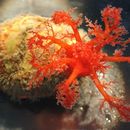Habitat
provided by Invertebrates of the Salish Sea
Rocks in exposed and sheltered inlets.
- license
- cc-by-nc-sa
- copyright
- Rosario Beach Marine Laboratory
Distribution
provided by Invertebrates of the Salish Sea
Geographical Range: Pribilof Islands and Gulf of Alaska to Baja California
- license
- cc-by-nc-sa
- copyright
- Rosario Beach Marine Laboratory
Habitat
provided by Invertebrates of the Salish Sea
Depth Range: Low intertidal zone to subtidal depths of 247m
- license
- cc-by-nc-sa
- copyright
- Rosario Beach Marine Laboratory
Comprehensive Description
provided by Invertebrates of the Salish Sea
Looks much like a chiton, especially when the oral tentacles are retracted. Shape is like a cucumber that has been sliced in half lengthwise as the soft, orange ventral side is almost perfectly flat. Ventral side is covered in tube feet. Upper surface is covered with overlapping calcareous plates, which are usually a reddish-orange color. The mouth is located on the upper surface some distance from the anterior end and is surrounded by 10 bright red oral tentacles of equal length. Length to 7 cm.
- license
- cc-by-nc-sa
- copyright
- Rosario Beach Marine Laboratory
Look Alikes
provided by Invertebrates of the Salish Sea
How to Distinguish from Similar Species: Psolidium bidiscum is more purplish in color and is smaller.
- license
- cc-by-nc-sa
- copyright
- Rosario Beach Marine Laboratory
Comprehensive Description
provided by Invertebrates of the Salish Sea
Biology/Natural History: P. chitonoides is essentially sedentary. The cucumber uses its ten equal tentacles to filter detritus from the water. Sticky pads on each tentacle capture the food particles. The tentacles contain toxic compounds called saponins to discourage fish from nibbling at them. Predators that ignore these chemicals or are not affected by them include Stimpson
- license
- cc-by-nc-sa
- copyright
- Rosario Beach Marine Laboratory

